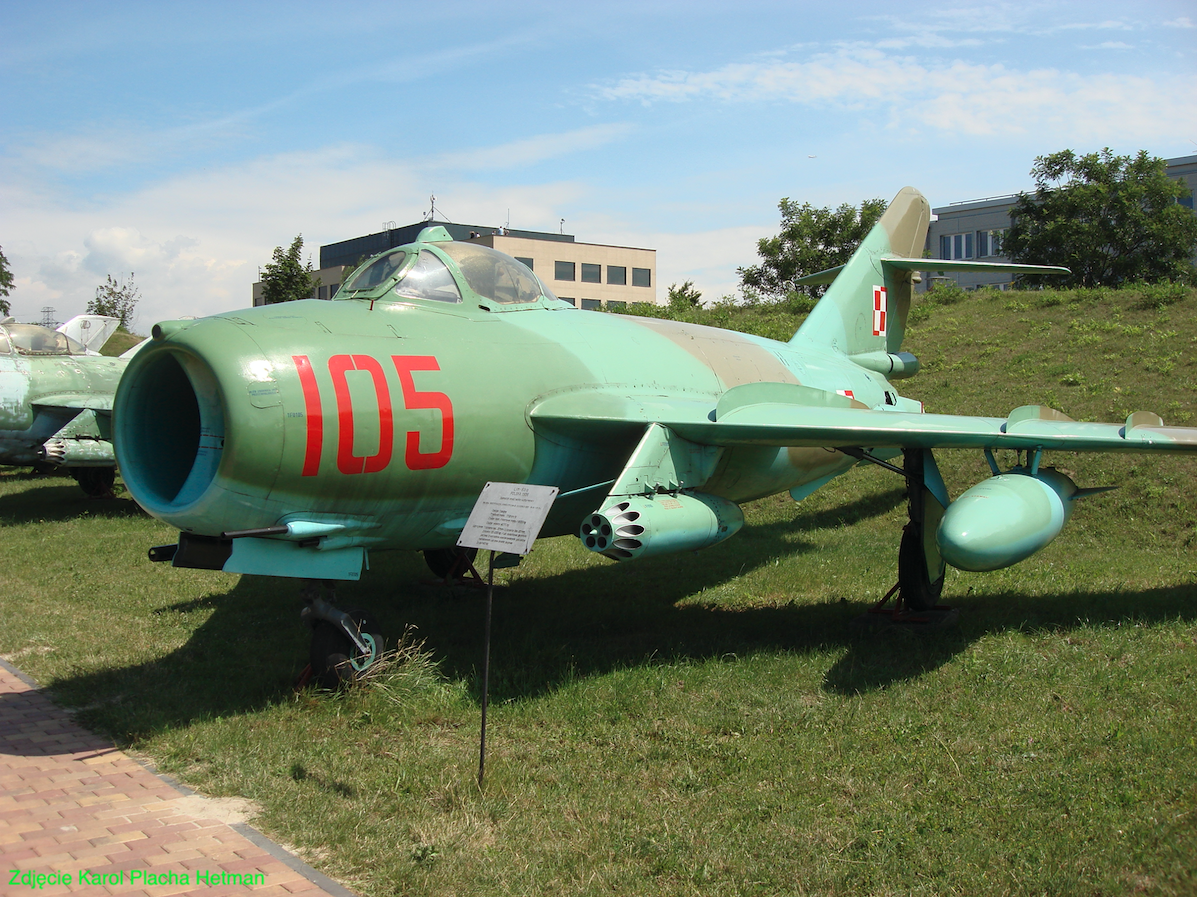Kraków 2025-04-24
WSK Mielec Lim-6 bis nb 105, 1F 01-05.
Lim-6 bis was a direct support fighter-attack aircraft.

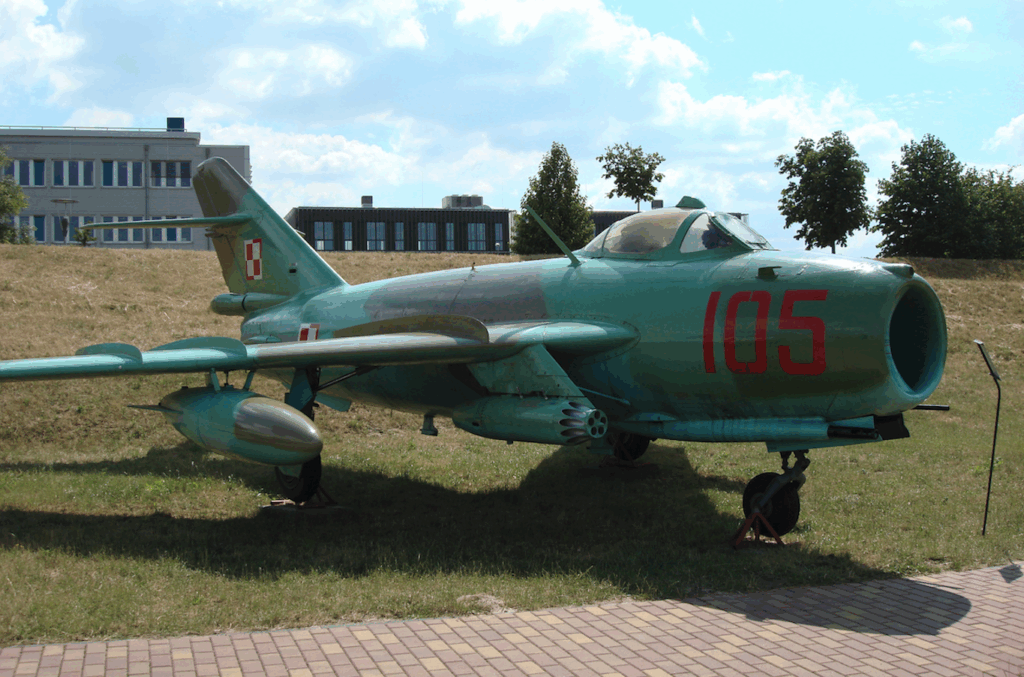
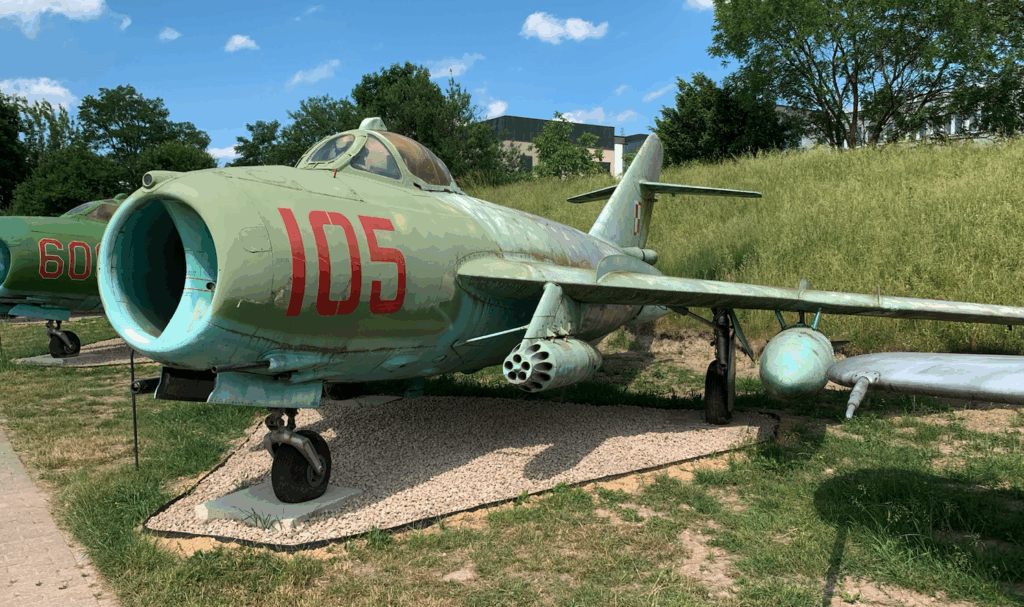
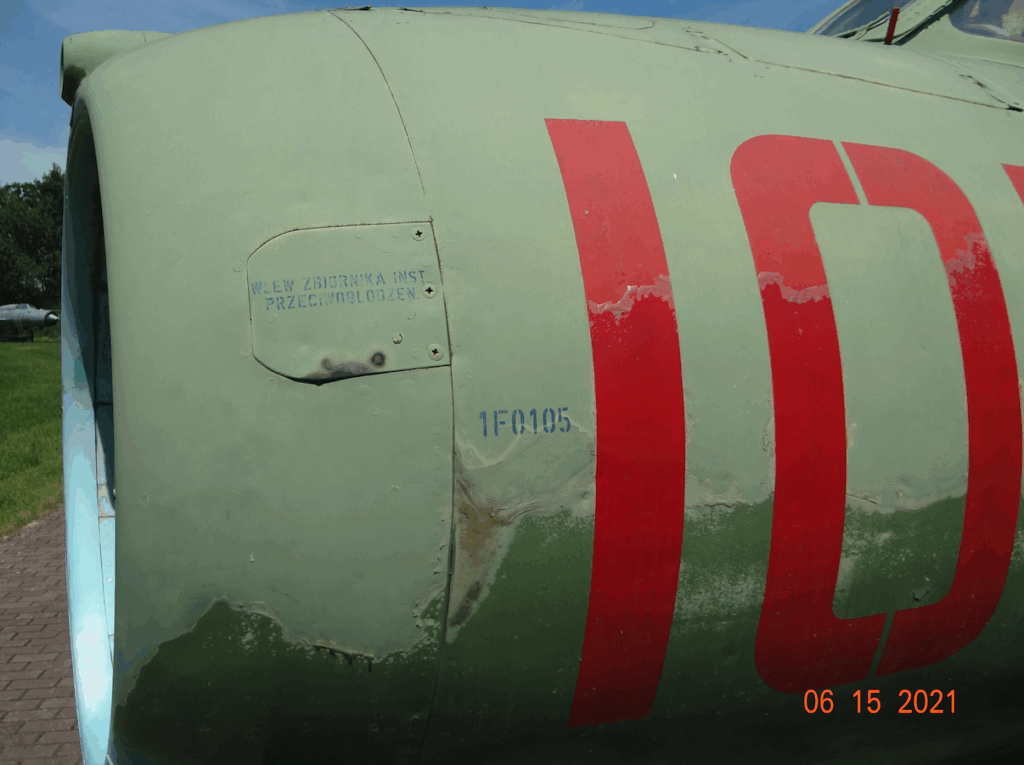
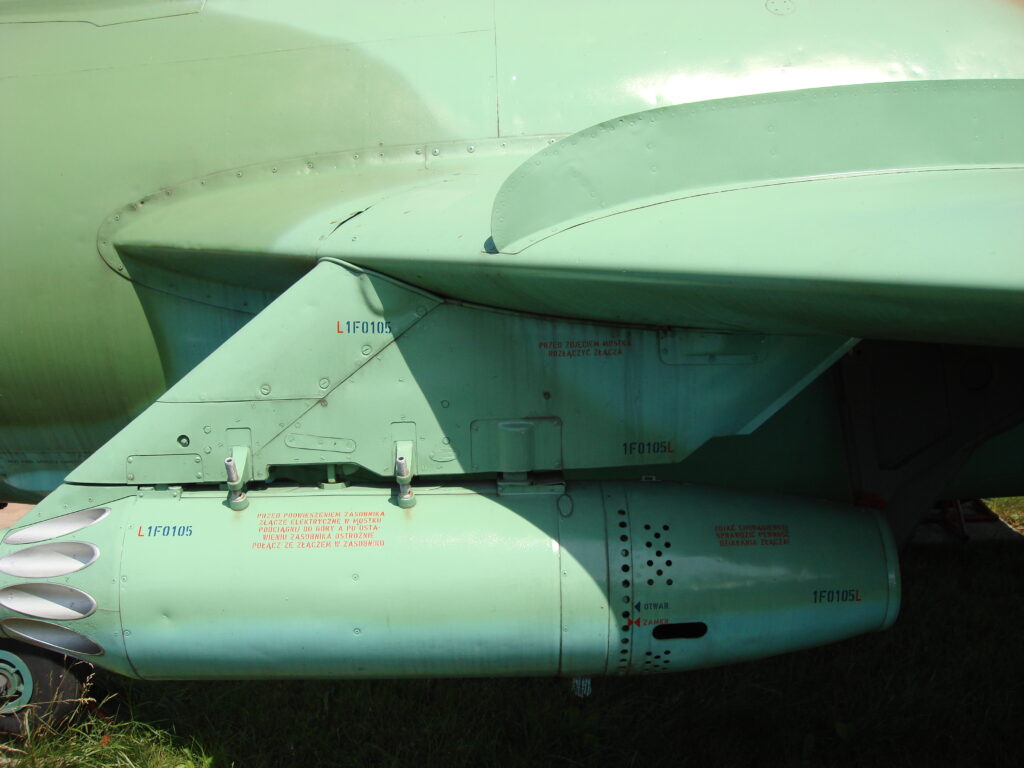
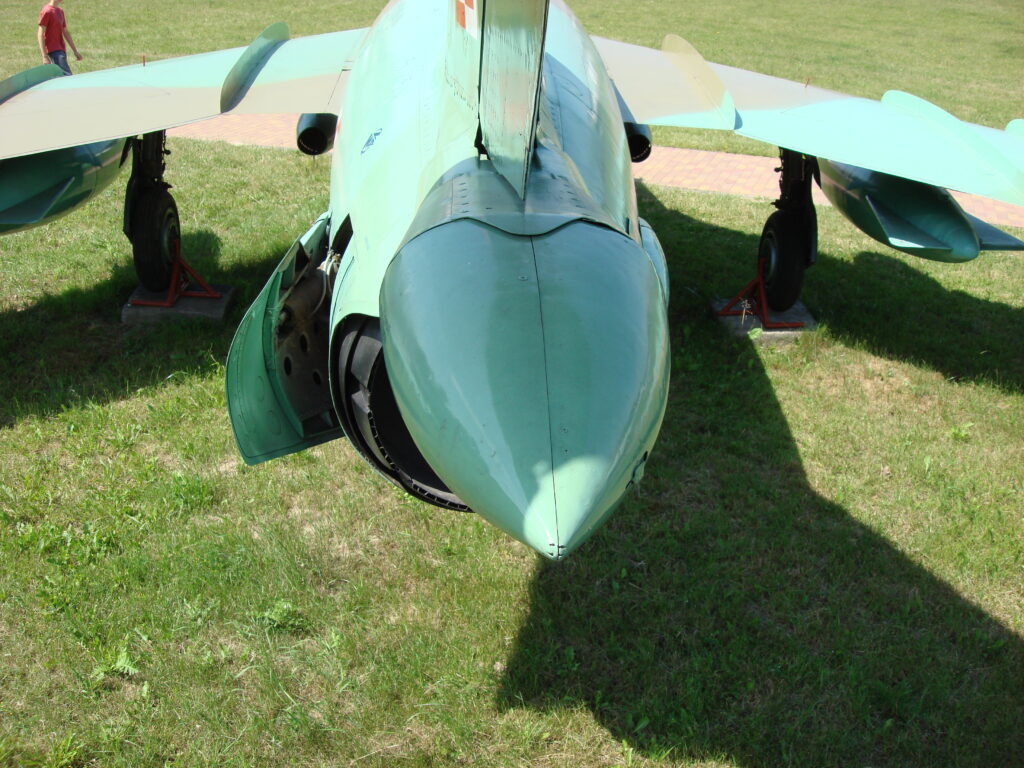
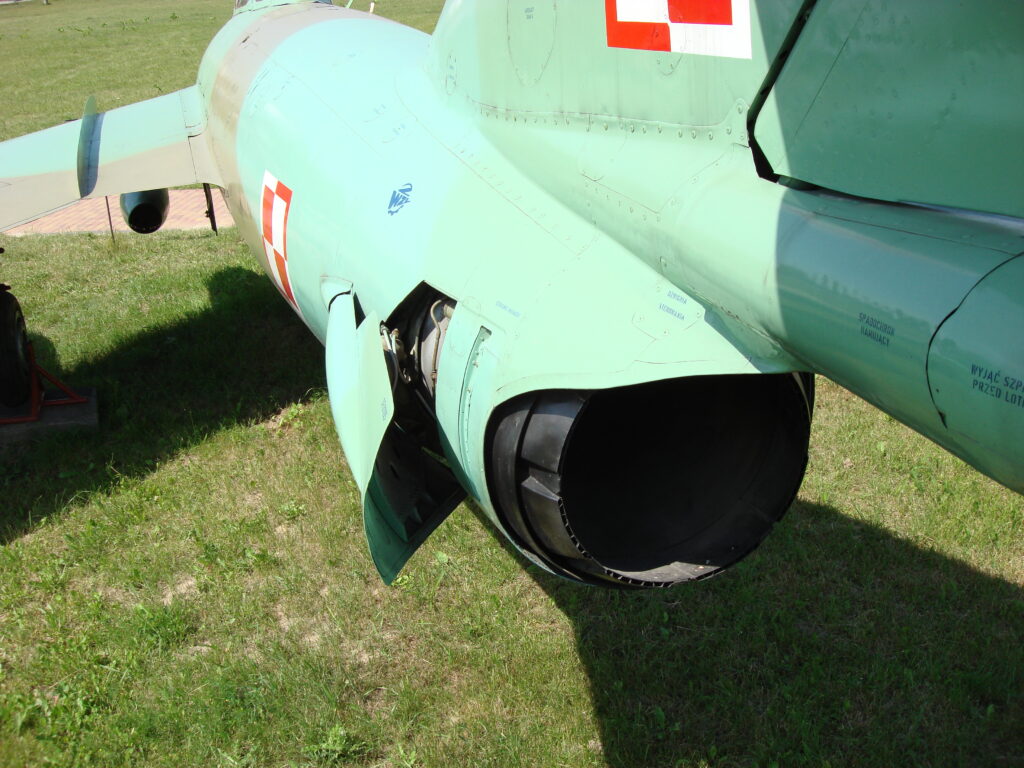
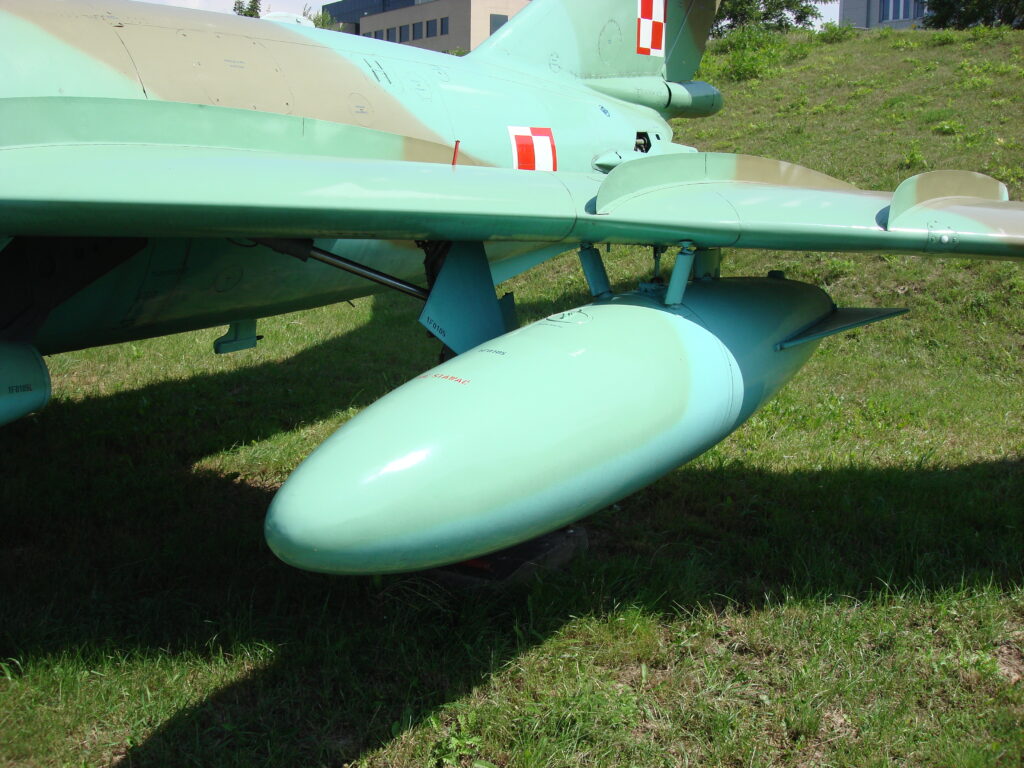
History of Lim-5 M. 1959.
In 1957, it was decided to modify the Lim-5 fighter aircraft and adapt it to attack tasks on the battlefield. The stimulus for the modification was familiarization with the requirements for a modern fighter-attack aircraft developed by the NATO headquarters in 1954. After a detailed analysis, it turned out that Lim-5 was close to meeting these requirements. The modification of the CF (Lim-5) aircraft was codenamed CM. At the beginning of 1958, work began in Mielec under the supervision of engineer Feliks Borodzik on the Lim-5 M aircraft.
At the beginning, the directions of necessary changes were determined: Adapt the aircraft to operate from field airports by using doubled main landing gear wheels. Shorten the aircraft’s take-off run by using a braking parachute. Shorten the aircraft’s take-off run by using rocket boosters. Analyze the possibility of using more effective wing mechanization. Increase the aircraft’s operational radius by adding a second pair of additional fuel tanks. Use rocket armament in the form of unguided rocket missiles. Due to the increase in the aircraft’s own weight, increasing the engine thrust was considered. Analyze the possibility of improving visibility from the cabin. They even considered moving the cabin forward and using side air intakes for the engine.
Due to the fact that the Lim-5 aircraft was a licensed version of the MiG-17 aircraft, and also due to the political realities prevailing at the time, on September 27, 1958, two designers from the PZL Mielec office went to Moscow for consultations. There, as a result of several meetings, including those with the participation of Artyom Mikoyan himself, the planned modification work was analyzed. The Soviet side confirmed the feasibility of the work being carried out.
In order to speed up the modernization, changes were introduced in stages. The army delivered a 1C 10-30 aircraft for reconstruction, and a few months later another 1C 16-01 aircraft.
At the beginning of 1958, the CM-I aircraft was created. Rocket accelerators, 2 x 9.81 kN, appeared on the sides of the rear part of the fuselage. In the place where the fuselage comb is, a PT-19 braking ribbon parachute was mounted (other sources indicate the symbol SH-19).
The prototype with the serial number CM-10-30 made its first flight on July 2, 1959. After completing the first stage tests, without approval and without waiting for the completion of the flights, serial production was prepared. The take-off weight of the CM-I aircraft in the fighter configuration was 5,697 kg, and in the attack configuration 5,762 kg. The maximum speed was 1,080 km/h, and the maximum ceiling was 14,100 m.
The CM-II project was created a little later than the CM-I (CM 10-30). This aircraft introduced doubled main landing gear wheels and fairing tanks on the fuselage in front of the wing. The fairing tanks held 560 liters of fuel. Initially, they were made of metal, and later of composite. At this stage, the CM-II aircraft was called Lim-5 M.
On December 28, 1959, both prototypes, already officially referred to as Lim-5 M, were transferred to a field airport and tested there. The aim of these tests was to determine whether the intended tactical and technical effects had been achieved. The results were positive. The doubled wheels ensured that the fighter was completely dependent on concrete runways. Even cracks during landing of one of the tires turned out to be harmless. The parachute shortened the take-off run by 250 m. The take-off run was slightly worse. The take-off run was extended by 40%, which was the result of the change in the wing aerodynamics. However, this was not taken into consideration, as the plan was to use take-off rockets, which were ultimately not tested. These tests were too much for the machine to be put into production.
The data of the Lim-5 M aircraft were impressive. The take-off run on the grass was 710-770 m, and with accelerators 350-370 m (estimated data). The take-off run was 1,140 m, and with a parachute 670 m. The armament included Mars tube launchers; 2 x 8 x S-5. Launchers for 16 or 24 rockets could also be suspended. The aircraft could have 2 x 3 heavy 132 mm caliber NPRs suspended by garlands. There was a possibility of various combinations of armament. The pilots called the aircraft a collar or a scarf because of the fairing-tanks.
On November 30, 1960, the first serial Lim-5 M was produced, number 1F 01-01. (After years, this aircraft was rebuilt into Lim-6 bis.) Serial production lasted until May 10, 1961 and ended with the construction of 60 aircraft in three series. The last one was 1F 03-30. Despite some reservations about the aircraft, the decision was made to accept it into service, which was officially made by Order of the Ministry of National Defense No. 035/MON issued on July 5, 1961.
From December 1960, Lim-5 M aircraft were transferred to the air force, but the Lim-5 M aircraft were not appreciated in the regiments. The aircraft caused great problems for its users. It turned out that the aircraft was difficult to fly. Its performance was worse than the standard Lim-5 aircraft. Flights were performed with significant limitations. The command assured the pilots that they would soon receive a new, improved type of attack aircraft. This did not happen until 1963. By that time, the equipment situation of the Operational Aviation was getting worse. There were even plans for an emergency purchase of 70 used Soviet MiG-17 aircraft, but this did not happen.
The Operational Aviation was created by separating the Air Force (WL) and the Anti-Air Defense of the Country Area (OPL OK) in 1962.
In the period of 1960-1961, 60 Lim-5 M aircraft were built, and were sent to the following combat units; 5 PLMSZ, 6 PLMSZ, 30 PLMSZ in Siemirowice and 48 PLMSZ. In 1963, the army had 44 Lim-5 M aircraft, respectively (18 in 5 PLMSZ, 14 in 6 PLMSZ, 16 in 30 PLMSZ and 12 in 48 PLMSZ). Lim-5 M aircraft were sent to Siemirowice, among others, in 1960. The 30 PLSZ (Air Assault Regiment) was stationed there, which changed its name to 30 PLMSZ (Fighter-Assault Regiment). In 1963, the regiment received TS-8 Bies training aircraft, and in 1964, Lim-6 bis aircraft, as described below. In 1967, 30 PLMSZ changed its name to 7 PLMSZ.
History of Lim-6.
Production of Lim-5 M aircraft did not mean the end of modernization work. It was related to the CM-II project. The basic subject of this project was the blowing of compressed air onto wing flaps. The aim was to achieve greater flap efficiency. Analysis showed that in order for the system to be fully effective, a plate-type horizontal tail should be used. However, such a tail was never built.
Work was carried out on the already known CM 10-30 model. The first tests of flaps with blowing were encouraging. The specific solution was tested from January 1961. The aircraft received the designation Lim-5 M-II. The engine adapted for blowing was designated Lis-5 M. The air for blowing was led from the engine through a pipe placed inside the wing and equipped with numerous nozzles. However, over time, problems arose. On 1961-01-07, the aircraft experienced its first pumping. Only in July 1961, the problem was successfully solved by installing non-return valves on the system. On March 29, 1962, after state tests, further tests with blowing were discontinued due to too small benefits and great difficulty in maintenance.
In 1960, the army additionally transferred the 1C 19-04 aircraft for tests.
The fully completed CM 16-01 was approved as a model for the CM-II program and given the designation Lim-5 M-II.
In May 1961, immediately after the end of production of the Lim-5 M aircraft, before the full tests of the Lim-5 M-II (CM 16-01) aircraft, a series of 40 units was built, which were finally given the designation Lim-6. The engines changed their designation from Lis-5 M to Lis-6. The aircraft bore numbers from 1J 04-01 to 1J 04-40. As a side note, it should be recalled that the CM 16-01 copy was rebuilt many times.
The Lim-6 aircraft received, in addition to the installation of a blower on the flaps and a parachute placed at the base of the empennage, many other minor changes. For example, additional side cooling of the engine, which was to be a prelude to the feasibility of developing side air intakes. However, in this form the Lim-6 aircraft was never taken over by the army. The Lim-6 aircraft were later rebuilt.
There were other modifications of the Lim-5 M aircraft, which were not implemented. Among them, an aircraft with containers on the ends of the wings, which housed cameras of various types. A system for shortening the landing run using two parachutes was also tested. Unfortunately, one parachute interfered with the opening of the canopy of the other, so the tests were not continued.
History of the Lim-6 bis. 1962.
The Polish Army did not accept the Lim-6 aircraft into service. Some of the Lim-6 aircraft were used for further tests. These included aircraft with the numbers; 1J 04-02, -03, -04, -05.
Information coming from the regiments about the operation of the Lim-5 M aircraft and the research being conducted forced further changes. On 1962-04-24, a meeting of the Technical Commission for the Lim-6 aircraft was held. Attention was drawn to the worsened handling with fairing-tanks and the low efficiency of the airflow on the flaps. It was postulated to abandon these solutions.
First, the fairing-tanks were eliminated. Aircraft with fairing-tanks had a thicker wing. In flight, it created greater resistance and increased fuel consumption. Additionally, as the fuel from the tanks was depleted, the center of gravity shifted. The maneuverability of the aircraft deteriorated, which was attributed to some accidents. The main goal – increasing the range was not so significant.
The landing gear with double wheels lasted longer. However, they required additional fairings, which worsened the flight characteristics. Tests showed vibrations and oscillations of the aircraft in flight. In addition, the importance of using ground airports decreased. Therefore, it was decided to abandon double wheels. Nevertheless, until the end of the aircraft’s service life, there was always the possibility of using this option and installing double wheels.
As mentioned above, the flap blower was also abandoned.
However, the aircraft had additional booms-hooks for weapons. On June 19, 1962, tests of the 1C 19-04 aircraft began. They concerned various variants of weapons. The tests were completed on August 6, 1962, after 63 flights. The test pilot was Z. Słonowski. Good flight characteristics were found, especially with the Mars-2 weapon on the inner nodes.
As we remember, the aircraft could be equipped with rocket accelerators. In the second half of 1962, it was planned to equip the aircraft with accelerators with a higher thrust, 2 x 11.77 kN. Ultimately, however, due to the smaller increase in the aircraft’s own weight, the rocket accelerators were abandoned.
On June 25, 1962, the Ministry of National Defense approved the assumption of the CMR program, i.e. the attack and reconnaissance version. As mentioned above, tests of various reconnaissance pods mounted under the wings ended in failure, so ultimately the cameras mounted only in the fuselage were left. This solution was tested from June to August 1962. On the sidelines, we will mention that the first Lim-5 aircraft equipped with the AFA-39 camera was the 1C 13-18, and the work was carried out in 1959.
On August 28, 1962, the first weapons tests were performed, when the Lim-6 bis CM 10-30 prototype used FAB-250, OFAB-100 bombs and S-5 unguided rockets.
On September 13, 1962, decisions were made: It was decided to reconstruct the produced Lim-6 aircraft to the Lim-6 bis standard, with the option of building 70 new aircraft by the end of 1963. For 1964, it was planned to build an additional 56 aircraft in the typical reconnaissance version of the Lim-6 R. The latter plan was not implemented, as production of the TS-11 Iskra aircraft was undertaken. It was therefore decided that the Lim-6 bis series V and VI aircraft would be equipped with an AFA-39 camera placed in the fuselage. The name Lim-6 bis R or Lim-6 R was even proposed, but this idea was abandoned.
On November 7, 1962, the final version of the attack aircraft was approved, called Lim-6 bis. On December 5, 1962, factory tests began, which lasted until 1963-04-16. At the beginning of 1963, the conversion of Lim-6 aircraft to the Lim-6 bis variant began. These were the ones that had been produced but not received by the military. The first 1J 04-07 aircraft left WSK Mielec on March 23, 1963. 70 more aircraft were built from scratch, in two series, V and VI. The last one was the 1J 06-40, built on February 25, 1964. All Lim-5 M aircraft were converted to the Lim-6 bis version. This work was carried out in LZR-4.
Later, another 1J 16-01 was transferred to military units, being the experimental CM 16-01 (June 15, 1965) and 1J 04-41 (September 30, 1969).
In the period from April 15, 1964 to June 27, 1964, the aircraft underwent state trials. Several minor defects were noted and their removal was ordered. The Lim-6 bis aircraft was officially accepted into service on September 14, 1964, when the state trials protocol was approved.
Lim-6 bis nb 105 No 1F 01-05.
Lim-6 bis nb 105 was built as Lim-5 M. The aircraft was transferred to the combat unit in Piła. It was then withdrawn from service and rebuilt into the Lim-6 bis version. The aircraft received the unchanged No. 1F 01-05 nb 105. The aircraft was operated in Piła, Mirosławiec and Babimost. During operation, it received camouflage. In 1990, it was sent to the slope in Mierzęcice, where it was preserved as a combat reserve. In 2004, it was transferred to the Polish Aviation Museum in Kraków. In the museum, the aircraft was repainted in camouflage and went to an outdoor exhibition, where it stands to this day (2025).
Written by Karol Placha Hetman

